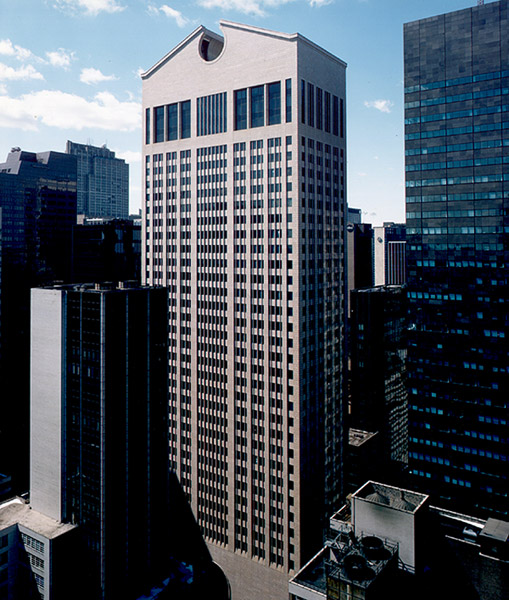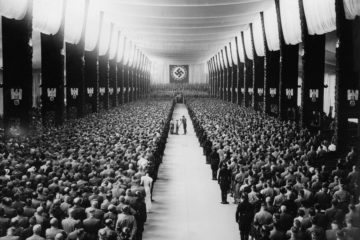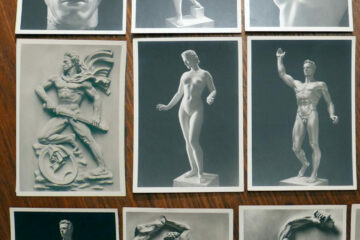Modern Architecture Is Shoddy As Well As Ugly

by Andrew Hamilton
THE MOST STRIKING feature of modern architecture is its ugliness. Inhuman and anti-human, it offends the soul and affronts the environment.
A core purpose of contemporary architecture is to insult good taste. Architects, architectural critics, and academics (paper architects) routinely exhibit contempt for builders, engineers, construction workers, maintenance staff, clients, property owners, occupants, passersby, and ordinary citizens.
When told by Hibbard Johnson of S.C. Johnson & Sons that the company’s roof leaked, Frank Lloyd Wright responded, “Move your chair.” He called another of his designs a “two-bucket house,” to which Philip Johnson rejoined that his own Glass House in Connecticut was a “four-bucket home.” Johnson said its windows shattered during storms, advising, “Don’t build a glass house if you’re worried about saving money on heating.”
Outré architecture, being the creation of eccentric “genius,” is hyped as art or sculpture divorced from function.
Though never explicitly stated or analyzed as far as I know, grotesque design goes hand in hand with shoddy construction. Problems can plague any building, but shoddiness appears to be a feature rather than a bug of modernism.
Many years ago social critic Tom Wolfe noted the prevalence of “flat roofs, which leaked from rain and collapsed from snow” and “glass walls, which let in too much heat, too much cold, too much glare, and no air at all” for occupants. (“The Great Relearning,” The American Spectator, December 1987.) He had earlier written a stinging critique of modern architecture, From Bauhaus to Our House (1981).
“The Ideal of Not Pleasing Is Fundamental to Modern Art”
Ugliness permeated Communist bloc and Socialist British architecture, and is commonplace in Israel — three Jewish power bases.
The first two united in the destruction of Germany and the creation of a totalitarian new world order, and both harbored intense hatred for Whites and Western civilization. George Orwell’s 1984 presents a keen psychological and moral portrait of these regimes.
Jews are delighted that most Whites harbor a visceral dislike for modern architecture. They revel in any discomfiture experienced by the people they hate the most.
Yet Jews create and celebrate these blots upon the landscape even in their own nation. They do not behave differently among themselves, at least in that regard.
The self-Chosen are proud of modernist structures, feel at home in them, and are oblivious to their grotesque appearance. Israel’s created landscape reifies an inner Jewish aesthetic.
In like manner, the countless state-mandated Holocaust memorials erected to instill reverence toward Jews and abhorrence of Europeans are uniformly unsightly, as intrinsically bizarre as the martyr fable they venerate. This is particularly telling, because the shrines are contemporary society’s holiest monuments.
Returning to the general topic, Frank Gehry’s (real name Frank Goldberg) “tin can” architecture is lavishly praised and promoted by fellow Jews including the billionaire Pritzker family, Israel’s Wolf Foundation, Hollywood movie director Sydney Pollack (PBS), and municipal, state, and national governments, universities, and other publicly-funded institutions.
Occasionally an Establishment Leftist states the obvious: Gehry’s commissions for governments and the super-wealthy amount to “design for the one percent.”
Garish modern designs are arbitrarily tacked onto native European structures when additions are needed.
“Canada’s most hated building,” the Michael Lee-Chin Crystal, jarringly protrudes from the Royal Ontario Museum. Widely feted by Establishment commentators, it was designed by racist architect Daniel Libeskind. The extension is named for the multibillionaire financial wheeler-dealer — a Jamaica-born Canadian Chigro — who donated the money to build it.
The interior is unloved even by some Politically Correct staff members because too many of the slanting walls and empty spaces can’t be used to display art, indicative of “serious” architecture’s disdain for rudimentary function.
Libeskind’s structure was used as the Museum’s main entrance. But a decade after it opened museum directors quietly paid another firm to create a conservative new entry in the old building: Libeskind’s Crystal entrance could not conveniently let people into and out of the building!
Libeskind “didn’t have the practical experience” “or perhaps the interest” “to work out the logistics” of doing so, it was gently averred. He disregarded “the nuts and bolts of making places that work.” Officials responsible for the monstrosity tapped Ontario’s taxpayers for an additional $1.5 million to make the necessary alterations.
Not all modernist architects and patrons are Jewish. Setting to one side a rogue’s gallery of conformists and opportunists, a nevertheless sizeable number of Whites patronize and design modernist structures. They must possess an inner aesthetic similar to Jews, or at least closely paralleling it.
The interiors of modern buildings are as alien and depressing as the exteriors.
And Shoddy, Too!
The term “shoddy construction” is misleading. Common failures are due to the caprice that outlandish design should take precedence over function, expense, the desires of the public, and everything else.
Problems are customarily design-, not construction-related. Sometimes modifications are needed solely because the structure or its elements do not serve their intended purpose.
Builders and engineers have no qualms about erecting such eyesores. It’s lucrative. I assume many are self-convinced enthusiasts of offensive architecture.
There is a sort of rough justice at work when builders are later sued because of problems. Litigation expenses are ultimately passed along to future clients (often publicly funded), and prices inflated accordingly.
The shiny stainless steel surfaces of Gehry’s $274-million Walt Disney Concert Hall in Los Angeles had to be painstakingly dulled with hand-held sanders equipped with 220-grit paper more than a year after their erection because they reflected blinding sunlight into neighboring condominiums, considerably raising temperatures inside. Mirrored sunlight also “roasted the sidewalk to 140 degrees Fahrenheit, enough to make plastic sag, cause serious sunburn to people standing on the street and create a hazard to drivers.”
Gehry’s Stata Center at the Massachusetts Institute of Technology was plagued by cracking masonry, poor drainage, mold growth, dangerous sliding ice and snow, and persistent leaks throughout the building.
The conceit that utility must be subordinated to pure form might have originated with Anglo- and Welsh-American architect Frank Lloyd Wright, an egotist famously dismissive of the clients who footed his bills. Other architects and art critics mimicked Wright as press and intellectuals lauded him and made him famous. Wright’s modernism appealed to this influential crowd, as did his arrogance, which conveniently served boundless egos and destructive objectives.
Wright, it should be said, was the inspiration behind Jewish novelist Ayn Rand’s architect-hero Howard Roark in The Fountainhead (1943). Donald Trump, who has commissioned many buildings, praises The Fountainhead and says he identifies with Roark.
The artistic affectations and behavioral traits displayed by Wright became ingrained in the profession and continued afterward. Aping Frank Lloyd Wright became de rigueur.
The client’s role, apart from fulsomely praising the narcissistic designer in unison with professors, critics, and assorted media hacks, is to fund the project, keep his mouth shut, and accept whatever the celebrity architect proposes and delivers.
It helps that clients are often officers of publicly-funded institutions. They lack a strong economic incentive to anticipate or prevent problems. Laborers will shoulder the bulk of those hassles later.
In 2001 an owner who lived in one of Wright’s houses complained that “trying to stop the constant leaks and resultant water damage and paying heating bills equal to our mortgage payments” is a constant headache.
Many of Wright’s houses and other buildings are extremely old by now. Time has taken its toll, and onerous historical preservation laws impose expensive barriers to renovation in many cases.
Still, many problems were apparent immediately upon completion, or before construction ended.
The roof of the Johnson Wax Headquarters in Racine, Wisconsin leaked, and the expensive three-legged chairs Wright designed tipped over when employees sat in them.
The American Institute of Architects’ “best all-time work of American architecture,”the Wright-designed Fallingwater residence near Pittsburgh, was marred from the beginning by the architect’s scorn for engineering advice. Its cantilevered balconies began to droop and crack, a problem consulting engineers had foreseen and warned about ahead of time.
Fallingwater was built in the 1930s as a weekend retreat for German Jewish department store magnate Edgar Kaufmann and his wife. Kaufmann had married his first cousin, and their homosexual son inherited the estate after his death in 1955. The Pittsburgh Post-Gazette hosts an undated but lengthy, lavishly-illustrated glorification of the wealthy clan written by a Jewish staff writer. (“The Kaufmann Legacy.”)
The Kauffmans commissioned another very early (1946) modernist residence, the Kaufmann House, for another estate they owned in Palm Springs. The California structure was designed by Jewish architect Richard Neustra, again suggesting an innate, race-based affinity for modern design, which Jews both patronize and create.
Frank Lloyd Wright’s Ennis House in Los Angeles has been featured in many TV shows and movies including The Day of the Locust (1975) and Blade Runner (1982) since first being showcased by Jewish B-movie director William Castle (William Schloss, Jr. from New York City) in House on Haunted Hill (1959) starring Vincent Price.
Even prior to completion Ennis House was marked by structural instability. The concrete blocks cracked and lower sections of the walls buckled under pressure. Use of decomposed granite to color Wright’s so-called “textile blocks” (designer concrete blocks he developed) introduced impurities into the concrete causing premature decay. A 1-minute 2018 video walkthrough displays this house in its most flattering light.
The Ennis House is “Mayan Revival” style, inspired by the architecture and iconography of pre-European Mayan and Aztec aesthetics. Wright designed several Mayan Revival structures, including Philadelphia’s Beth Sholom Synagogue.
An Instauration magazine reader familiar with modernist Philip Johnson’s Art Museum of South Texas on the Gulf of Mexico wrote,
Johnson built an art museum in Corpus Christi on the bay front with the load and unloading door facing the salt water and opening directly into the storage area, which has no humidity or air conditioning control. The building was designed to exhibit “modern art,” but to get some of the stuff into the building they have to almost tear down the front entrance because the doors are too narrow. Altogether the “carved marshmallow” (Johnson’s phraseology) is a solid concrete echo chamber incapable of adequate soundproofing. The back door is so low that an extremely high tide can flood the lower floor. (Feb. 1977, p. 2)
Johnson was a homosexual who had an affair with a Negro cabaret singer in Harlem in the 1930s. An Ohio native, the architect was of Anglo-American and Dutch descent.
His forebear Jacques Cortelyou, born in Holland to French Huguenot parents, was New Amsterdam’s Surveyor General and created the first town plan at the southern tip of Manhattan Island for Peter Stuyvesant. Johnson’s middle name was Cortelyou.
The architect has been castigated by Jews and Leftists as a “Nazi” because of his alleged political views and activities in the 1930s and 40s. As usual, the party line is summarized by Wikipedia. Given its penchant for lying about racial matters, weighty independent evidence of a substantial nature would be needed before accepting such claims, as well as information about how much Johnson crawled afterward.
Not All of It Is Bad
Not all modern architecture is ugly.
Though entirely fictional (it existed only in MGM set designs in Hollywood), Frank Lloyd Wright’s overall style inspired the conceptually intriguing modernist residence atop South Dakota’s Mount Rushmore in Alfred Hitchcock’s suspense thriller North by Northwest (1959). This is where Cary Grant rescued Eva Marie Saint from the clutches of suave Communist villain James Mason at movie’s end.
A notable real-life exception to the Rule of Ugliness is Philip Johnson’s AT&T Building (today known as “550 Madison Avenue”).

Another example is César Pelli’s modern art deco Wells Fargo Center in Minneapolis. Like Johnson, a lot of Pelli’s work is unattractive. But both men possessed the talent to create beautiful buildings.
The Argentinian Pelli, who immigrated to the U.S., is an example of what happens when countries do not protect the racial integrity of their people and a complex racial amalgam results.
Pelli is said to have had an Italian paternal grandfather, and his mother has been called (without backup evidence, unfortunately) “criollo,” which may signify Spanish settler descent, either in whole or in part. Since Pelli was born nearly a century ago (1926), he might have been exclusively Italian-Spanish. But he could just as easily have been Mestizo or even, I suppose, part Jewish. Trustworthy genealogical information would be needed to determine his race.
A more characteristically modern but nevertheless striking structure is Los Angeles’s Stahl House (1960) designed by Jewish architect Pierre Koenig.
The house’s appeal has a lot to do with its unique location and the building’s successful integration into it.
More importantly, a series of highly mannered, artfully composed photographs staged by Jewish still photographer Julius Shulman in 1960, in particular a night shot of two girls in white dresses, subsequently reinforced by the house’s use as a setting or backdrop in dozens of TV shows, movies, music videos, and commercials, created a powerful representation that exists primarily in the human imagination rather than reality. Rare photographs taken from uncommon perspectives disclose a less magical structure.

This is a specific instance of a more general phenomenon.
Direct experience is limited. Most of what we “know” derives from media, which generate a fictitious collective consciousness (including false architectural landscapes) that reproduces itself in every individual’s mind.
Think “Cambridge University.” The name will conjure up a certain picture in your mind, whether or not you have ever been there. But it will not match reality.

Visualize “Washington, D.C.”
In your mind’s eye you will see a handful of classical buildings familiar from countless photographs, TV shows, Hollywood movies, etc., to which you have been exposed over the years: the White House, Capitol, Supreme Court building, Washington Monument, Lincoln Memorial, the reflecting pool, and cherry trees in blossom.
Next run your eyes over photographs of typical government buildings.
The two are totally different. But it is the first, essentially fictitious image that dominates human imagination the world over.
The original deed for the Stahl House contained a restrictive covenant: “The area that included the lot had legally filed Covenants, Conditions, and Restrictions from 1948 that indicated ‘the property shall not, nor shall any part thereof be occupied at any time by any person not of the Caucasian race, except that servants of other than the Caucasian race may be employed and kept thereon.’”
Covenants of this type were later outlawed to prevent Whites from voluntarily living together, a violation of fundamental freedom.
Open glass structures like the Stahl House, highly popular among modernists, are generally impractical for the non-wealthy.
Aside from increased maintenance and repair costs caused by the elements — sun, wind, rain, snow, heat, and cold — and lack of privacy if not situated on a large private estate, such structures cannot provide security against social and racial violence. Elites who foster violence are shielded from harm, so personal safety of that kind is not an issue for them.
Finally, the house is perched precariously on the edge of a cliff, an imprudent place to build even in regions not prone to earthquakes.
As far as I know the Stahl House has not been plagued by design-related construction defects so common in modern architecture. Despite its age, alterations have apparently been minor and cosmetic.
* * *
Source: Author











Wow the first picture of what is now MIT is truly hideous and an utter pox on the great inventions that came out of that institution. It literally looks like a kindergarten school project made out of kitchen graters, match boxes and biscuit tins shoddily glued together. It is however inline with imbeciles on TV that are portrayed as geniuses like “The Good Doctor”. Retarded people are also portrayed as scientific geniuses such as Stephen Hawking. Everything is turned on its head and with double think (some are more equal than others). I think it all gets back to power, the more the Jews can subvert and stupefy their host countries populace the easier it is for them to rule, steal and enslave. One other element about creating something so… Read more »
The main image, which is the one with the peach colored, angled buildings, appears horrid to the eyes because everything is jumbled together like hodgepodge. There are some nice features such as the amphitheatre and rooftop garden, and the rhomboid shapes mingle decently with the surrounding architecture, but there is no center, no order, no cohesion. The angles of the buildings are seemingly placed arbitrarily, with no sense of form, and the mirrored chrome is an affront against the apricot facade. Mind you, that is only a picture of this particular building. I imagine it sticks out like a mole needing to be whacked from a further vantage point. That said, when it comes to architecture, even if a building is meant to stand out, there must be a semblance… Read more »
I thought the Guggenheim museum in NYC vaguely resembled a giant toilet bowl: https://www.flickr.com/photos/132084522@N05/17207156426/ , courtesy of Frank Lloyd Wright’s architecture. Was Wright secretly critiquing the building’s contents? I now think it resembles one of the most destructive forces of nature, the tornadic mesocyclone: Part-jew Solomon Guggenheim was a promoter of “modern art”, which has been well exposed for what most of it is on NV: https://en.wikipedia.org/wiki/Solomon_R._Guggenheim
Part-jew Solomon Guggenheim was a promoter of “modern art”, which has been well exposed for what most of it is on NV: https://en.wikipedia.org/wiki/Solomon_R._Guggenheim
I don´t think it quite right to lump Frank Lloyd Wright with the Jewish culture destroyers. He was one of the few real artists you Americans can claim as your own. His vision of an organic ¨Usonian¨ architecture, unique to North America and serving the needs of its Aryan population, was a concept to which greater heed should have been paid. As he was dedicated the the idea that a structure should be designed for utility, beauty and in the ¨nature of its materials,¨ and that such materials be natural as far as possible, his artistic vision often outstripped his engineering sense. However, his buildings, while unique, never sacrificed beauty and function for uniqueness and ostentation. There is not one of his creations one can point to and say, this… Read more »
I stated that Wright was Anglo-Welsh. (He was Welsh on his mother’s side.) He was not Jewish, if for some reason that wasn’t clear. From the standpoint of racial analysis this is indeed very important. Wright’s work is not aesthetically pleasing, though it can fairly be said that as a rule it is not horrible like so much modern architecture. Even the designer concrete “textile blocks” he came up with are intriguing, as the article I linked to about them demonstrates. Still, concrete and glass as dominant building materials do not work well, aesthetically or otherwise. New York City’s Solomon R. Guggenheim Museum of modern art, alluded to by commenter Sethmoto, is positively ugly. True, Wright desired a stone rather than concrete finish, which would have helped, but not decisively.… Read more »
Not only ugly and shoddy. A new DC tribute to irrationality: https://www.kennedy-center.org/reach/
Jews had contributed practically nothing to art, literature, architecture or music prior to the first half of the last century, when they were given every privilege imaginable to finally do so by the White man. Even since then, their talents have been wildly oversold. With a few notable exceptions in both pop and higher culture, they tend to gravitate towards vulgarity or schlock. (Think of the songs White Christmas and Easter Parade, which reduce the two high-points of the Christian year to weather and fashion. Or the cinematic work of Steven Spielberg, which is paint-by-numbers formulaic dross, infinitely less preferable to low-budget, straight-to-DVD action movies.) This demographic generally escapes criticism because when Jews are not being deliberately elusive, they can always level charges of anti-Semitism, or remind us all about… Read more »